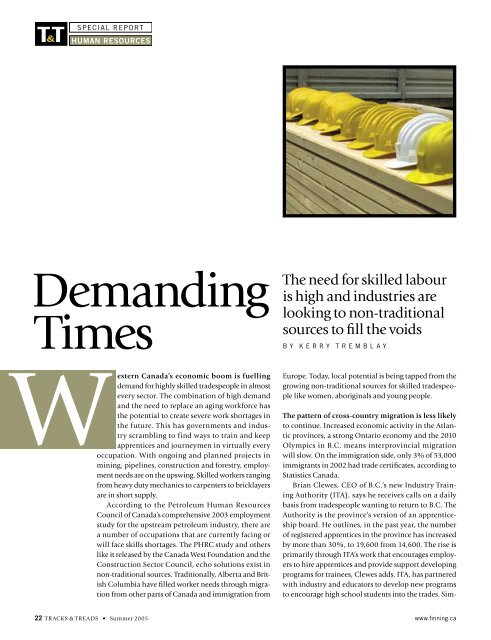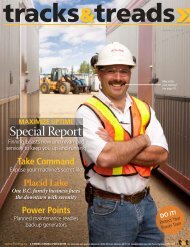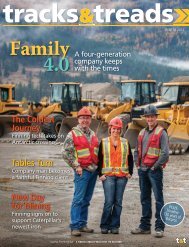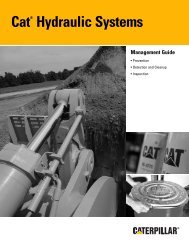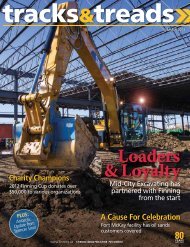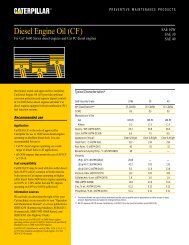SPECIAL REPORTHUMAN RESOURCESSPECIAL REPORTHUMAN RESOURCESINDUSTRY REPORTLANDSCAPINGDemandingTimesWestern <strong>Canada</strong>’s economic boom is fuellingdemand for highly skilled tradespeople in almostevery sector. The combination of high demandand the need to replace an aging workforce hasthe potential to create severe work shortages inthe future. This has governments and industryscrambling to find ways to train and keepapprentices and journeymen in virtually everyoccupation. With ongoing and planned projects inmining, pipelines, construction and forestry, employmentneeds are on the upswing. Skilled workers rangingfrom heavy duty mechanics to carpenters to bricklayersare in short supply.According to the Petroleum Human ResourcesCouncil of <strong>Canada</strong>’s comprehensive 2003 employmentstudy for the upstream petroleum industry, there area number of occupations that are currently facing orwill face skills shortages. The PHRC study and otherslike it released by the <strong>Canada</strong> West Foundation and theConstruction Sector Council, echo solutions exist innon-traditional sources. Traditionally, Alberta and BritishColumbia have filled worker needs through migrationfrom other parts of <strong>Canada</strong> and immigration fromThe need for skilled labouris high and industries arelooking to non-traditionalsources to fill the voidsB Y K E R R Y T R E M B L A YEurope. Today, local potential is being tapped from thegrowing non-traditional sources for skilled tradespeoplelike women, aboriginals and young people.The pattern of cross-country migration is less likelyto continue. Increased economic activity in the Atlanticprovinces, a strong Ontario economy and the 2010Olympics in B.C. means interprovincial migrationwill slow. On the immigration side, only 3% of 53,000immigrants in 2002 had trade certificates, according toStatistics <strong>Canada</strong>.Brian Clewes, CEO of B.C.’s new Industry TrainingAuthority (ITA), says he receives calls on a dailybasis from tradespeople wanting to return to B.C. TheAuthority is the province’s version of an apprenticeshipboard. He outlines, in the past year, the numberof registered apprentices in the province has increasedby more than 30%, to 19,600 from 14,600. The rise isprimarily through ITA’s work that encourages employersto hire apprentices and provide support developingprograms for trainees, Clewes adds. ITA, has partneredwith industry and educators to develop new programsto encourage high school students into the trades. Sim-22 TRACKS & TREADS • Summer 2005 www.finning.ca
HUMAN RESOURCESSPECIAL REPORTHUMAN RESOURCESINDUSTRY REPORTLANDSCAPINGilar to Alberta’s Registered Apprenticeship Program(RAP), B.C.’s Accelerated Enrolment in Industry Training(ACE-IT) is currently being launched. The programallows senior high students the opportunity to completethe first year of technical training in a trade whilethey continue earning high school credits for graduation.There is a sister program for young people alreadyworking part time as apprentices in industry. It providescredit for on-the-job time, a jump start on hoursneeded to become journeymen and a scholarship.Thinking outside the box, the ITA is involved withnew, easily-accessible and relevant programs to allowindustries and companies to train the workers for specificskills. For example, the ITA now recognizes a framingprogram, a forming program and a rebar program.All are geared to tie into eventual journeyman statusand the ability to meet the criteria for the Red Seal.With the help of industry, there is also a move afootto recognize and train for “multi-skilling”. “These arebroader apprenticeships,” Clewes outlines. “For example,an industry might need to have a skilled personwho is an industrial electrician, who can also do somebasic millwright and instrumentation work.”Skilled workers rangingfrom heavy duty mechanicsto carpenters to bricklayersare in short supplyRay Jeffery, manager of Learning and Developmentat <strong>Finning</strong> (<strong>Canada</strong>) is a tradesman with 40 years experienceand is a senior member of Alberta’s Apprenticeshipand Industry Training Board. “The challenge isthat we need to market the trades – not to the kids,but to the parents,” he says. “The trades are not secondbest!” Jeffery and Clewes outline the trades need to beseen as a viable and rewarding first career choice for students.“At <strong>Finning</strong> some skilled tradespeople have beenpulling wrenches for 35 years and really like it,” Jefferyexplains. “Others have moved into sales or supervisorypositions after only a few years in the trades.“Everything is going really well (in the economy),and that means trade people are at a premium,” he says.It means a strong demand for equipment sales and service.And there lies the challenge. “The rate of growth inbusiness means that the demand (for qualified heavyduty mechanics) is outstripping supply,” Jeffery says.Shortages sparked the unique, <strong>Caterpillar</strong>-specifictraining program called “Think Big”, offered throughthe Northern Alberta Institute of Technology (NAIT).Officially called the <strong>Caterpillar</strong> Dealer Service TechnicianProgram, the training is a two-year partnershipbetween <strong>Caterpillar</strong>, NAIT and <strong>Finning</strong>.Faced with inconsistently-trained mechanics in theUnited States, <strong>Caterpillar</strong> training specialists designeda Cat-specific program. It passed the program on toNAIT (at the Fairview campus), which provides theinstructors and technical school setting. <strong>Finning</strong> offersbursaries, a loaner tool program that sees top studentsreceive more than $9,000 worth of tools free at the endof the program. Students participate in five, eight-weekwork-experience sessions.Graduates of the two-year program earn the chanceto challenge the Heavy Equipment Technician AlbertaApprenticeship Examination to become eligible for fulljourneymen status after fulfilling the required hourson the job. NAIT’s first Think Big class graduated thisApril. “The entrance requirements are high,” says Jeffery.“Students require English, Math and Physics at the30-level and Grade 12. This is the real world and wecan’t afford to drop our standards.” Think Big is a keypart of the company’s three-pronged strategy to ensurea supply of qualified technicians.Roger Dootson, district manager at PCL ConstructionManagement Inc. for Northern Alberta and theNorthwest Territories, has some of the same challengesfinding skilled construction workers and dealswith recruiting in various ways. For heavy industrialwork, including shutdowns and electrical work, PCLcompanies work directly with unionized labour. Forcommercial and institutional projects in Alberta andSaskatchewan, PCL companies use labour brokers,whose job it is to ferret out the type and number of fieldpersonnel needed. PCL works with about 150 apprenticesin a variety of fields on an assortment of sites inWestern <strong>Canada</strong>. Even with that number of trainees,there remains a high demand for carpenters, concretelabourers, crane operators and cement finishers.www.finning.ca Summer 2005 • TRACKS & TREADS 23


